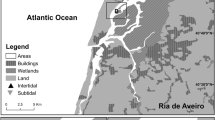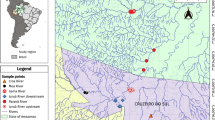Abstract
The burrowing and movement ability of the New Zealand cockle Austrovenus stutchburyi is reduced when infected by echinostome trematodes. Previous experimental evidence from a single site suggests that this parasite-induced behavioural change of a key bivalve can affect the structure of the surrounding benthic community. By using multiple regression analyses on data collected from 17 intertidal flats, we here show that cockle parasitism is associated with macrozoobenthic community structure on a larger spatial scale. Regressions were performed for animal abundance, biomass, species diversity and species richness separately, entering cockle parasitism (infection intensity), presence/absence of ghost shrimps (Callianassa filholi), cockle density, primary producer abundance and organic content, particle size, sorting coefficient and gravel content of the substrate as predictors. Next to ghost shrimps, cockle parasitism was the best predictor of animal abundance by affecting (mainly positively) 8 of the 49 most widespread species significantly. Cockle parasitism was also associated with the biomass of anthozoans (positively), nemerteans (negatively) and bivalves (positively), whereas overall animal biomass was positively related to the sorting coefficient of the substrate. Species diversity was positively associated with cockle parasitism and gravel content of the substrate. Species richness was significantly associated with cockle parasitism (positively), ghost shrimps (negatively) and abundance of primary producers (positively) in combination. The impact of cockle parasitism on benthic community structure is believed governed directly or indirectly by (1) reduced sediment disturbance, (2) increased surface structural complexity and (3) availability of larval trematodes as an additional food source.






Similar content being viewed by others
References
Admiraal W (1984) The ecology of estuarine sediment-inhabiting diatoms. Prog Phycol Res 3:269–322
Allison FR (1979) Life-cycle of Curtuteria australis n.sp. (Digenea, Echinostomatidae, Himasthlinae), intestinal parasite of the South Island pied oystercatcher. N Z J Zool 6:13–20
Amaral ACZ, Denadai MR, Turra A, Rizzo AE (2003) Intertidal macrofauna in Brazilian subtropical tide-dominated sandy beaches. J Coast Res 35:S446–S455
Babirat C, Mouritsen KN, Poulin R (2004) Equal partnership: two trematode species, not one, manipulate the burrowing behaviour of the New Zealand cockle, Austrovenus stutchburyi. J Helminthol 78:195–199
Ballard HR (1990) MacRSA: Macintosh application program for rapid sediment analysis. University of Otago, Dunedin
Berkenbusch K, Rowden AA (1999) Factors influencing sediment turnover by the burrowing ghost shrimps Callianassa filholi (Decapoda: Thalassinidea). J Exp Mar Biol Ecol 238:283–292
Berkenbusch K, Rowden AA, Probert PK (2000) Temporal and spatial variation in macrofauna community composition imposed by ghost shrimps Callianassa filholi bioturbation. Mar Ecol Prog Ser 192:249–257
Branch GM, Pringle A (1987) The impact of the sand prawn Callianassa kraussi Stebbing on sediment turnover and bacteria, meiofauna, and benthic microflora. J Exp Mar Biol Ecol 107:219–235
Buchanan JB (1984) Sediment analysis. In: Holme NA, McIntyre AD (eds) Methods for the study of marine benthos, 2nd edn. Blackwell, Oxford, pp 41–65
Butler S, Bird FL (2007) Estimating density of intertidal ghost shrimps using counts of burrow openings. Is the method reliable? Hydrobiologia 589:303–314
Byers JE, Blakeslee AMH, Linder E, Cooper AB, Maguire TJ (2008) Controls of spatial variation in the prevalence of trematode parasites infecting a marine snail. Ecology 89:439–451
Combes C (1996) Parasites, biodiversity and ecosystem stability. Biodivers Conserv 5:953–962
Currie DR, Small KJ (2006) The influence of dry-season conditions on the bottom dwelling fauna of an east Australian sub-tropical estuary. Hydrobiologia 560:345–361
Flach EC (1995) The influence of the cockle, Cerastoderma edule, on the macrozoobenthic community of tidal flats in the Wadden Sea. Mar Ecol 17:87–98
Fredensborg BL, Mouritsen KN, Poulin R (2006) Relating bird host distribution and spatial heterogeneity in trematode infections in an intertidal snail: from small to large scale. Mar Biol 149:275–283
Fujii T (2007) Spatial patterns of benthic macrofauna in relation to environmental variables in an intertidal habitat in the Humber estuary, UK: Developing a tool for estuarine shoreline management. Estuar Coast Shelf Sci 75:101–119
Gross K, Cardinale BJ (2007) Does species richness drive community production or vice versa? Reconciling historical and contemporary paradigms in competitive communities. Am Nat 170:207–220
Hopper JV, Poulin R, Thieltges DW (2008) Buffering role of the intertidal anemone Anthopleura aureoradiata in cercarial transmission from snails to crabs. J Exp Mar Biol Ecol 367:303–314
Jones CG, Lawton JH, Shachak M (1997) Positive and negative effects of organisms as physical ecosystem engineers. Ecology 78:1946–1957
Krebs CJ (1999) Ecological methodology, 2nd edn. Addison-Welsey, Menlo Park
Lefèvre T, Lebarbenchon C, Gauthier-Clerc M, Missé D, Poulin R, Thomas F (2009) The ecological significance of manipulative parasites. Trends Ecol Evol 24:41–48
Lepitzki DAW, Scott ME, McLaughlin JD (1994) Influence of storage and examination methods on the recovery and size of metacercariae of Cyathocotyle bushiensis and Spaeridotrema pseudoglobulus (Digenea). J Parasitol 80:454–460
Lorentzen CJ (1967) Determination of chlorophyll and pheo-pigments: spectrophotometric equations. Limnol Oceanogr 12:343–346
Martorelli SR, Poulin R, Mouritsen KN (2006) A new cercaria and metacercaria of Acanthoparyphium (Echinostomatidae) found in an intertidal snail Zeacumantus subcarinatus (Batillaridae) from New Zealand. Parasitol Int 55:163–167
Minchella DJ, Scott ME (1991) Parasitism: a cryptic determinant of animal community structure. Trends Ecol Evol 6:250–254
Mouritsen KN (2002) The parasite-induced surfacing behaviour in the cockle Austrovenus stutchburyi: a test of an alternative hypothesis and identification of potential mechanisms. Parasitology 124:521–528
Mouritsen KN (2004) Intertidal facilitation and indirect effects: causes and consequences of crawling in the New Zealand cockle. Mar Ecol Prog Ser 271:207–220
Mouritsen KN, Haun SCB (2008) Community regulation by herbivore parasitism and density: trait-mediated indirect interactions in the intertidal. J Exp Mar Biol Ecol 367:236–246
Mouritsen KN, Poulin R (2002) Parasitism, community structure and biodiversity in intertidal ecosystems. Parasitology 124:S101–S117
Mouritsen KN, Poulin R (2003a) Parasite-induced trophic facilitation exploited by a non-host predator: a manipulator’s nightmare. Int J Parasitol 33:1043–1050
Mouritsen KN, Poulin R (2003b) The mud flat anemone-cockle association: mutualism in the intertidal zone? Oecologia 135:131–137
Mouritsen KN, Poulin R (2005a) Parasites boost biodiversity and change animal community structure by trait-mediated indirect effects. Oikos 108:344–350
Mouritsen KN, Poulin R (2005b) Parasitism can influence the intertidal zonation of non-host organisms. Mar Biol 148:1–11
Mouritsen KN, Poulin R (2006) A parasite indirectly impacts both abundance of primary producers and biomass of secondary producers in an intertidal benthic community. J Mar Biol Assoc UK 86:221–226
Mouritsen KN, Mouritsen LT, Jensen KT (1998) Change of topography and sediment characteristics on an intertidal mud-flat following mass-mortality of the amphipod Corophium volutator. J Mar Biol Assoc UK 78:1167–1180
Pillay D, Branch GM, Forbes AT (2007) Effects of Callianassa kraussi on microbial biofilms and recruitment of macrofauna: a novel hypothesis for adult-juvenile interactions. Mar Ecol Prog Ser 347:1–14
Posey MH (1986) Changes in a benthic community associated with dense beds of a burrowing deposit feeder, Callianassa californiensis. Mar Ecol Prog Ser 31:15–22
Posey MH, Alphin TD, Cahoon L (2006) Benthic community responses to nutrient enrichment and predator exclusion: influence of background nutrient concentrations and interactive effects. J Exp Mar Biol Ecol 330:105–118
Reise K (1985) Tidal flat ecology. An experimental approach to species interactions. Springer, Berlin
Siebert T, Branch GM (2005) Interactions between Zostera capensis and Callianassa kraussi: influences on community composition of eelgrass and sandflats. Afr J Mar Sci 27:357–373
Snelgrove PVR, Butman CA (1994) Animal sediment relationships revisited—cause and effect. Oceanogr Mar Biol 32:111–177
Sousa WP (1991) Can models of soft-sediment community structure be complete without parasites? Am Zool 31:821–830
Stewart MJ, Creese RG (2002) Transplants of intertidal shellfish for enhancement of depleted populations: preliminary trials with the New Zealand little neck clam. J Shellfish Res 21:21–27
Thieltges DW, Jensen KT, Poulin R (2008a) The role of biotic factors in the transmission of free-living endohelminth stages. Parasitology 135:407–426
Thieltges DW, de Montaudouin X, Fredensborg B, Jensen KT, Koprivnikar J, Poulin R (2008b) Production of marine trematode cercariae: a potentially overlooked path of energy flow in benthic systems. Mar Ecol Prog Ser 372:147–155
Thomas F, Poulin R (1998) Manipulation of a mollusc by a trophically transmitted parasite: convergent evolution or phylogenetic inheritance? Parasitology 116:431–436
Thomas F, Renaud F, de Meeûs T, Poulin R (1998) Manipulation of host behaviour by parasites: ecosystem engineering in the intertidal zone? Proc R Soc Lond B 265:1091–1096
Thomas F, Adamo S, Moore J (2005) Parasitic manipulation: where are we and where should we go? Behav Processes 68:185–199
Valiela I (1995) Marine ecological processes. Springer, Berlin
Werner EE, Peacor SD (2003) A review of trait-mediated indirect interactions in ecological communities. Ecology 84:1083–1100
Whitlatch RB, Hines AH, Thrush SF, Hewitt JE, Cummings V (1997) Benthic faunal responses to variation in patch density and patch size of a suspension-feeding bivalve. J Exp Mar Biol Ecol 216:171–189
Wood CL, Byers JE, Cottingham KL, Altman I, Donahue MJ, Blakeslee AMH (2007) Parasites alter community structure. Proc Natl Acad Sci 104:9335–9339
Ysebaert T, Herman PMJ (2002) Spatial and temporal variation in benthic macrofauna and relationships with environmental variables in an estuarine, intertidal soft-sediment environment. Mar Ecol Prog Ser 244:105–124
Ziebis W, Forster S, Huettel M, Jørgensen BB (1996) Complex burrows of the mud shrimp Callianassa truncata and their geochemical impact in the sea bed. Nature 382:619–622
Acknowledgments
We thank Gerd Banke, Brian Fredensborg, Karina Holmes, Maureen Howard, Susan Lusseau, Matthew McArthur and Kate Steger for technical assistance. The Danish Natural Science Research Council (KNM), the Marsden Fund and a James Cook Research Fellowship from the Royal Society of New Zealand (RP) provided funding.
Author information
Authors and Affiliations
Corresponding author
Additional information
Communicated by U. Sommer.
Electronic supplementary material
Below is the link to the electronic supplementary material.
Rights and permissions
About this article
Cite this article
Mouritsen, K.N., Poulin, R. Parasitism as a determinant of community structure on intertidal flats. Mar Biol 157, 201–213 (2010). https://doi.org/10.1007/s00227-009-1310-2
Received:
Accepted:
Published:
Issue Date:
DOI: https://doi.org/10.1007/s00227-009-1310-2




